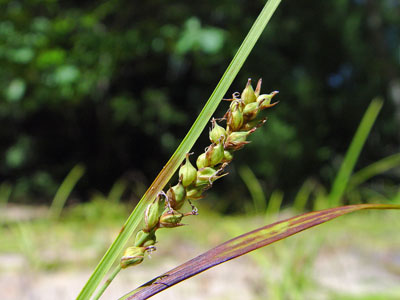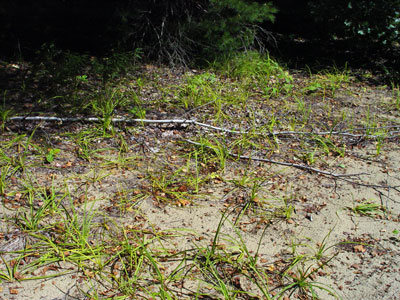DACF Home → Bureaus & Programs → Maine Natural Areas Program → Communities, Plants, and Animals → Rare Plants → Carex polymorpha
Carex polymorpha Muhl.

Variable Sedge
- State Rank: S1
- Global Rank: G3
- State Status: Endangered
Habitat: In Maine, habitat is between downslope seeps (with horsetails and wetland sedges) and upslope mixed oak/huckleberry forest. Preferred soil type is Deerfield Loamy Sand. All Maine occurrences are from coastal towns where climate is moderated by the ocean. [Dry barrens (partly forested, upland); Hardwood to mixed forest (forest, upland); Old field/roadside (non-forested, wetland or upland)]
Range: Southern Maine and southern New Hampshire to Virginia; rare throughout.
Aids to Identification: The genus Carex contains 150 species in Maine, but there are several characteristics distinguishing C. polymorpha from its close relatives in the Paniceae, a species-group to which it belongs. Rather than growing in clumps, variable sedge has spreading, loosely rooting rhizomes like all members of the Paniceae. Within this group, variable sedge can be distinguished by its long beak on the perigynium, a sac surrounding the achene. The perigynia grow in rows of three or more in the fertile spikes. The lowermost leaves lack a blade and all leaves are a pastel green color in early summer and tawny yellow by mid-September.

Ecological characteristics: Carex polymorpha tends to produce abundant fertile (flowering) shoots when growing in full sun and when free from dense competing vegetation. In shaded forest settings, the plant produces very few fertile shoots, though the sterile (non-flowering) shoots can be large and apparently vigorous. It seems likely that increases in light brought about by natural blowdown of trees, fire or logging will stimulate fertile shoot formation in this species. Though the effects of fire on C. polymorpha have not been precisely determined, persistent growth of the plant in burned areas suggests that it withstands, and possibly is enhanced by, fire. Fires might be important in terms of stimulating fertile shoot formation since competing woody vegetation is diminished. However, in the absence of fire, the plant can persist and produce fruit in forest settings. It generally grows in mixed woods with oak and pine in sandy soils.
Phenology: Flowering occurs between May 16 and 24 in Maine . The female flowers appear first, and seeds mature about eight weeks after flowering. Leaves of the vegetative shoots begin to turn yellow and die back around mid-September.
Family: Cyperaceae
Synonyms: None noted.
Known Distribution in Maine: This rare plant has been documented from a total of 5 town(s) in the following county(ies): Cumberland, York.
Reason(s) for rarity: Northern limit of range; scarce throughout its range.
Conservation considerations: Some known populations have succumbed to conversion of their habitat to residential or commercial use; others are vulnerable. Others have declined due to recreational overuse of their habitat by all-terrain vehicles.